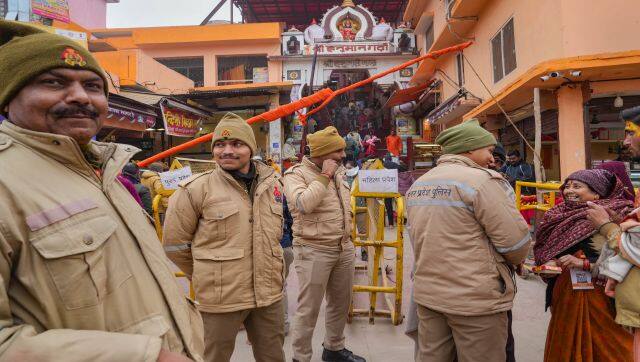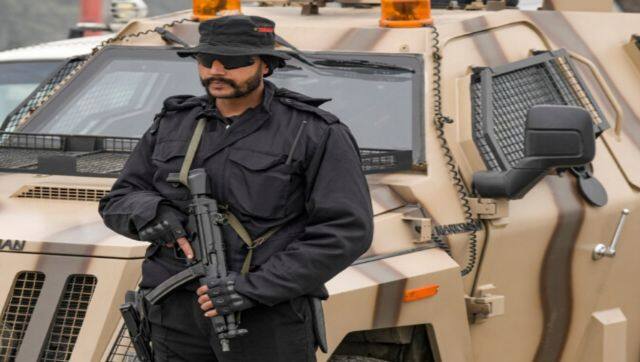Anticipation and spiritual fervour are reaching unprecedented heights as the grand ‘Pran Pratishtha’ ceremony of the Ram Mandir is set to unfold on 22 January in the sacred city of Ayodhya. The town is buzzing with excitement, but it’s not just about celebration – security is top-notch. Authorities are using a mix of manpower and tech, including drones with anti-drone features and
AI in cameras.
The aim? To keep a close eye on everything during the ceremony. Transportation won’t be a hassle either, with plans to inform the public in advance about any diversions. Local authorities are getting everything in order for the crowd. With enhanced security measures and logistical planning, they’re ensuring a smooth experience for everyone attending this historic ‘Pran Pratishtha’ ceremony at the Ram Temple. Here’s a closer look. Over 10,000 CCTV cameras installed in Ayodhya In a bid to ensure robust security arrangements for the ‘pran pratishtha’ ceremony, 10,000 CCTV cameras have been installed in the entire district and multilingual policemen in plain clothes will be deployed at the venue, officials said on Tuesday. “In some of these CCTV cameras, we are using AI-based technology so that we can maintain a strict vigil on the commuters,” Director General (DG), Law and Order, Prashant Kumar, told PTI, adding multilingual police personnel will be deployed in plain clothes at the programme venue and they have been given training in proper soft skills.
Also Read: What is the Jagannath Temple Project to be inaugurated before Ram Mandir event?
With a 90-day recording capacity, these high-tech cameras will provide continuous surveillance, capturing footage from key locations across the city. “We have made all the arrangements. We are alert and we are not just relying on our manpower but also taking the help of technology, which we keep on continuously upgrading,” Praveen Kumar, IG Ayodhya Zone, told ANI. “Multiple drones will be active throughout the event and with the help of anti-drone solutions, we will keep an eye on drones being flown without permission. We have also used AI in our cameras,” he further added. Red and yellow zones Despite the challenges, Kumar is confident that the ‘Pran Pratishtha’ will be organised in the great manner. Echoing his sentiments, DG Prashant Kumar, told PTI, “The ‘pran pratishtha’ ceremony, which will be held on
22 January
, is going to be a historic event. For this, the UP Police has made elaborate security arrangements and along with it, security has been ensured for every road along the entire red zone, yellow zone and Ayodhya district.” [caption id=“attachment_13622842” align=“alignnone” width=“640”] Police personnel stand guard outside Hanuman Garhi temple, ahead of Shri Ram Janmabhoomi Temple consecration ceremony, in Ayodhya. PTI[/caption] To manage the influx of visitors and facilitate seamless traffic flow, the Intelligent Traffic Management System (ITMS) project will be implemented at 20 crucial locations in
Ayodhya
. Areas under vigilant traffic monitoring include popular spots like Riqabganj, Civil Line, Hanuman Cave, and many more. Emergency call boxes strategically placed at these locations will enable immediate communication with the central control room in case of emergencies, providing crucial assistance. “We have converted all the major roads coming towards Ayodhya into green corridors so that traffic is not disrupted. Heavy traffic has been diverted around Ayodhya since 18 January and a traffic advisory has also been issued in this regard,” Kumar added. The senior police official said the security of Saryu river, which flows in Ayodhya, has also been increased and added the security arrangements will be ensured through use of power boats, the NDRF and SDRF teams, and with local boatmen. “We are coordinating with other agencies. Checking is going on at the international and inter-state border. Police will use drones for crowd control and for diversion of excess crowd. We will use anti-drone technology at the programme venue so that security arrangements remain in place,” he said. “Our aim is to make such transport arrangements that people face no problem. We will inform the public about the diversion plans in advance to ensure no one faces any inconvenience,” said IG Kumar, reports ANI. Additional trains, GRP and RPF at stations The UP Police have also made extensive security arrangements for the Ayodhya railway station and the satellite railway stations surrounding it. As per a Times of India report, around 200 Government Railway Police (GRP) personnel, 400 Railway Protection Force (RPF) men and two companies of PAC will be deployed at the railway station. [caption id=“attachment_13622862” align=“alignnone” width=“640”]
Police personnel stand guard outside Hanuman Garhi temple, ahead of Shri Ram Janmabhoomi Temple consecration ceremony, in Ayodhya. PTI[/caption] To manage the influx of visitors and facilitate seamless traffic flow, the Intelligent Traffic Management System (ITMS) project will be implemented at 20 crucial locations in
Ayodhya
. Areas under vigilant traffic monitoring include popular spots like Riqabganj, Civil Line, Hanuman Cave, and many more. Emergency call boxes strategically placed at these locations will enable immediate communication with the central control room in case of emergencies, providing crucial assistance. “We have converted all the major roads coming towards Ayodhya into green corridors so that traffic is not disrupted. Heavy traffic has been diverted around Ayodhya since 18 January and a traffic advisory has also been issued in this regard,” Kumar added. The senior police official said the security of Saryu river, which flows in Ayodhya, has also been increased and added the security arrangements will be ensured through use of power boats, the NDRF and SDRF teams, and with local boatmen. “We are coordinating with other agencies. Checking is going on at the international and inter-state border. Police will use drones for crowd control and for diversion of excess crowd. We will use anti-drone technology at the programme venue so that security arrangements remain in place,” he said. “Our aim is to make such transport arrangements that people face no problem. We will inform the public about the diversion plans in advance to ensure no one faces any inconvenience,” said IG Kumar, reports ANI. Additional trains, GRP and RPF at stations The UP Police have also made extensive security arrangements for the Ayodhya railway station and the satellite railway stations surrounding it. As per a Times of India report, around 200 Government Railway Police (GRP) personnel, 400 Railway Protection Force (RPF) men and two companies of PAC will be deployed at the railway station. [caption id=“attachment_13622862” align=“alignnone” width=“640”] Security personnel stand guard on a road, ahead of Shri Ram Janmabhoomi Temple consecration ceremony, in Ayodhya. PTI[/caption] A control room will also be established at the DGP headquarters to provide round-the-clock monitoring. The first plan for 100 days has been implemented, and deployment tweaks will most likely be made based on footfall. Also, 20 additional trains are planned to arrive in Ayodhya from the south and west of India following the consecration event, increasing passenger capacity at Salarpur, Darshannagar, and Narendradev railway stations, the report added. The technology used The grand ceremony is set to witness a unique blend of technology and tradition. To control unauthorised access, boom barriers, also known as “tyre killers,” have been strategically placed at various locations, including hotels and offices. These barriers serve as a formidable deterrent, effectively blocking roadways and securing access points throughout the city. In an effort to combat potential security threats from the sky, the Uttar Pradesh Police will employ state-of-the-art anti-drone technology. It involves the use of systems that can detect and intercept unwanted drones. Additionally, electro-optical and infrared sensors will play a crucial role in detecting drones through their visual and heat signatures, ensuring a comprehensive defence against aerial threats. In another noteworthy move, the government has acquired 25 advanced telescopes designed by Raghunath Manohar from the Manipal Institute of Technology. These telescopes, equipped with a sophisticated optical system, are designed to enhance distant object visibility, adding an extra layer of surveillance capability. Social media networks such as Facebook, Instagram, and others will also be actively scrutinised for indicators of potentially harmful activities. With inputs from PTI and ANI
Security personnel stand guard on a road, ahead of Shri Ram Janmabhoomi Temple consecration ceremony, in Ayodhya. PTI[/caption] A control room will also be established at the DGP headquarters to provide round-the-clock monitoring. The first plan for 100 days has been implemented, and deployment tweaks will most likely be made based on footfall. Also, 20 additional trains are planned to arrive in Ayodhya from the south and west of India following the consecration event, increasing passenger capacity at Salarpur, Darshannagar, and Narendradev railway stations, the report added. The technology used The grand ceremony is set to witness a unique blend of technology and tradition. To control unauthorised access, boom barriers, also known as “tyre killers,” have been strategically placed at various locations, including hotels and offices. These barriers serve as a formidable deterrent, effectively blocking roadways and securing access points throughout the city. In an effort to combat potential security threats from the sky, the Uttar Pradesh Police will employ state-of-the-art anti-drone technology. It involves the use of systems that can detect and intercept unwanted drones. Additionally, electro-optical and infrared sensors will play a crucial role in detecting drones through their visual and heat signatures, ensuring a comprehensive defence against aerial threats. In another noteworthy move, the government has acquired 25 advanced telescopes designed by Raghunath Manohar from the Manipal Institute of Technology. These telescopes, equipped with a sophisticated optical system, are designed to enhance distant object visibility, adding an extra layer of surveillance capability. Social media networks such as Facebook, Instagram, and others will also be actively scrutinised for indicators of potentially harmful activities. With inputs from PTI and ANI
How security is being beefed up in Ayodhya ahead of Ram Mandir event
FP Explainers
• January 17, 2024, 10:59:58 IST
Ayodhya is buzzing with excitement ahead of the Ram Mandir inauguration, and security is top-notch. Authorities are using a mix of manpower and technology to keep a close eye on the grand ceremony scheduled for 22 January
Advertisement
)
End of Article